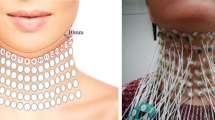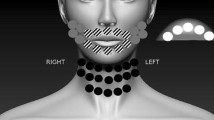Abstract
Masseter is a type of muscle which involves in the process of chewing. Any disorder in the masseter muscle creates dysfunction of the entire mastication process and leads to neuromuscular problems. Electromyograms (EMGs) act as a diagnostic tool in detecting any abnormalities present in the nervous and muscular system. The objective of this work is to record and analyze the electrical activity of the masseter muscle of healthy subjects during resting and chewing conditions. In this work, the electrical activity of the masseter muscle was recorded form healthy volunteers of different age, using non invasive surface electrodes. The EMG signals are recorded from left as well as right sides in resting and chewing conditions. The characteristics of the EMG signals in resting and chewing conditions are analyzed using various statistical measures, Fast Fourier Transforms (FFT) and Hjorth parameters such as complexity, activity, and mobility. Results demonstrate that the EMG signals acquired at resting conditions of different subjects have equal peak frequencies in the FFT. However, there is a significant shift in the peak frequency of the EMG signals during chewing activity. Furthermore, it is observed that there are variations in both the Hjorth parameters as well as the statistical parameters of EMG signals recorded during resting and chewing conditions. Results show that there is a significant change in the electrical activity of masseter muscle in the resting and chewing conditions. This work appears to be of high clinical significance, since the electrical activity of masseter muscle can provide diagnostic information for the analysis of various diseases in the oral structures.









Similar content being viewed by others
References
Alagumariappan P, Krishnamurthy K, Kandiah S, Ponnuswamy MJ (2017) Effect of electrode contact area on the information content of the recorded electrogastrograms: an analysis based on Rényi entropy and Teager-Kaiser Energy. Pol J Med Phys Eng 23(2):37–42
Ambikapathy B, Krishnamurthy K (2018) Analysis of electromyograms recorded using invasive and noninvasive electrodes: a study based on entropy and Lyapunov exponents estimated using artificial neural networks. J Ambient Intell Humaniz Comput 1–9
Ambikapathy B, Kirshnamurthy K, Venkatesan R (2018) Assessment of electromyograms using genetic algorithm and artificial neural networks. Evol Intell 1–11
Bakiya A, Kamalanand K (2018) Information analysis on electromyograms acquired using monopolar needle, concentric needle and surface electrodes. In: 2018 International Conference on Recent Trends in Electrical, Control and Communication (RTECC), IEEE, pp. 240–244
Bakiya A, Kamalanand K, Rajinikanth V, Nayak RS, Kadry S (2018) Deep neural network assisted diagnosis of time-frequency transformed electromyograms. Multimed Tools and Appl 1–17
Buesa-Bárez JM, Martín-Ares M, Martínez-Rodríguez N, Barona-Dorado C, Sanz-Alonso J, Cortés-Bretón-Brinkmann J, Martínez-González JM (2018) Masseter and temporalis muscle electromyography findings after lower third molar extraction. Med Oral, Patol Oral y Cir Bucal 23(1):e92
Hamida STB, Ahmed B, Penzel T (2015) A novel insomnia identification method based on Hjorth parameters. In: 2015 IEEE International Symposium on Signal Processing and Information Technology (ISSPIT), IEEE, pp 548–552
Jamal MZ (2012) Signal acquisition using surface EMG and circuit design considerations for robotic prosthesis. In: Computational Intelligence in Electromyography Analysis-A Perspective on Current Applications and Future Challenges, vol 18, pp 427–448
Mioche L, Bourdiol P, Martin JF, Noël Y (1999) Variations in human masseter and temporalis muscle activity related to food texture during free and side-imposed mastication. Arch Oral Biol 44(12):1005–1012
Mouzé-Amady M, Horwat F (1996) Evaluation of Hjorth parameters in forearm surface EMG analysis during an occupational repetitive task. Electroencephalogr Clin Neurophysiol/Electromyograph Mot Control 101(2):181–183
Nascimento GKBO, Cunha DAD, Lima LMD, Moraes KJRD, Pernambuco LDA, Régis RMFL, Silva HJD (2012) Surface electromyography of the masseter muscle during chewing: a systematic review. Revista CEFAC 14(4):725–731
Nishi SE, Basri R, Alam MK, Komatsu S, Komori A, Sugita Y, Maeda H (2017) Evaluation of masticatory muscles function in different malocclusion cases using surface electromyography. J Hard Tissue Biol 26(1):23–28
Rahal A, Goffi-Gomez MVS (2009) Electromyographic study of the masseter muscle during dental clenching and habitual chewing in adults with normal dental occlusion. Revista da Sociedade Brasileira de Fonoaudiologia 14(2):160–164
Rizal A, Hadiyoso S (2015) ECG signal classification using Hjorth Descriptor. In: 2015 International Conference on Automation, Cognitive Science, Optics, Micro Electro-Mechanical System, and Information Technology (ICACOMIT), IEEE, pp 87–90
Woźniak K, Lipski M, Lichota D, Szyszka-Sommerfeld L (2015) Muscle fatigue in the temporal and masseter muscles in patients with temporomandibular dysfunction. BioMed research international, 2015
Yuen SWH, Hwang JCC, Poon PWF (1989) EMG power spectrum patterns of anterior temporal and masseter muscles in children and adults. J Dent Res 68(5):800–804
Author information
Authors and Affiliations
Corresponding author
Additional information
Publisher's Note
Springer Nature remains neutral with regard to jurisdictional claims in published maps and institutional affiliations.
Rights and permissions
About this article
Cite this article
Arockia Sukanya, S., Kamalanand, K., Thayumanavan, B. et al. Time domain analysis on myoelectric activity of masseter muscles in resting and chewing conditions. Netw Model Anal Health Inform Bioinforma 9, 18 (2020). https://doi.org/10.1007/s13721-020-0224-2
Received:
Revised:
Accepted:
Published:
DOI: https://doi.org/10.1007/s13721-020-0224-2




